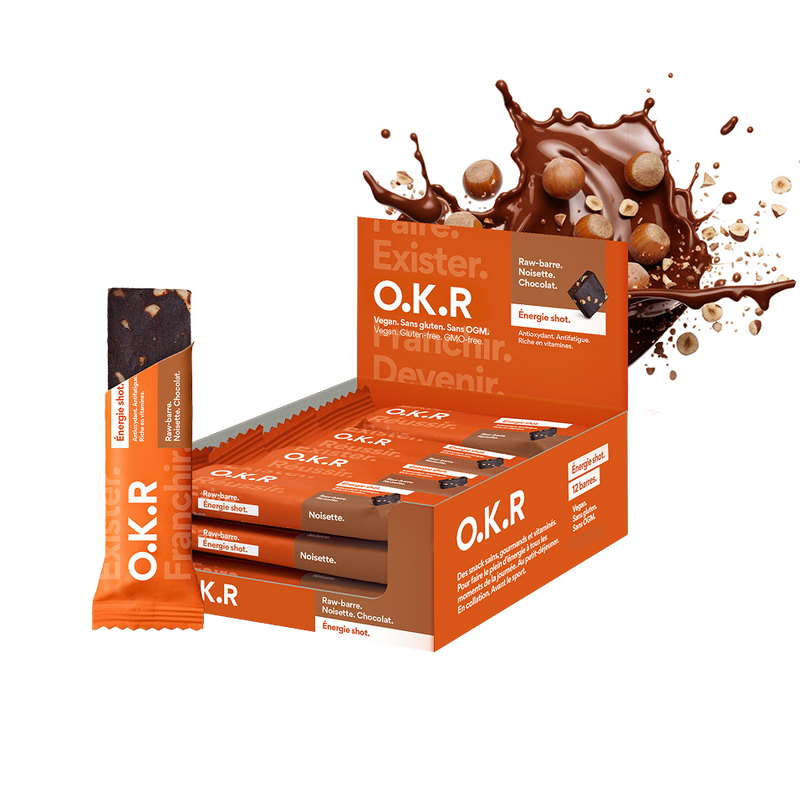What is a calorie?
Kilocalories measure the energy you consume and need for your body to function. Scientists define kilocalories as the amount of energy needed to raise the temperature of one liter of water by one degree Celsius. The calorie content of a food tells us how much energy that product will provide you.
The body continually burns calories to ensure vital functions (breathing, thinking, sleeping) but also during physical exertion such as walking. It is important to meet your energy needs throughout the day with occasional calorie intake from food. "How do I know if I'm consuming too many or too few calories?" The energy the body needs depends on several parameters, the main ones being age, sex, weight, height, and level of physical activity. When you eat an amount of food that provides you with as much energy as you burn during the day, you are in a balanced situation. You then maintain weight homeostasis, meaning your weight remains stable because all the calories absorbed have been expended.
In the situation where caloric intake is greater than daily energy expenditure, excess nutrients absorbed are stored either:
- In the muscle, in the form of glycogen and/or muscle proteins depending on physical activity, but in limited quantity
- In fatty tissues in the form of triglycerides called body fats responsible for weight gain.
Conversely, if energy expenditure exceeds calorie intake, you are in a calorie deficit situation which will lead to weight loss.
Reminder.
A calorie is a unit of energy. All foods contain calories. However, while all foods contain calories, they do not all have the same calorie content. This difference in the energy value of foods is explained by the macronutrients that compose them.
What are the calories in our food?
Foods are composed primarily of macronutrients: carbohydrates, fats, and proteins. They all provide calories, but the amount each contains will vary.
- Carbohydrates: 4 kcal per gram
- Lipids: 9 kcal per gram
- Protein: 4 kcal per gram
That’s a total of 386 kcal, the rest being provided by fibers which are a little energetic.
1. Carbohydrates.
Too familiarly referred to as sugars, carbohydrates are an important source of energy that is easily usable by your body. They are the essential fuel for your body.
There are two types of carbohydrates:
- Simple carbohydrates: They are a source of energy that can be quickly used by the body.
→ Sugar, honey, syrup, candy, can of soda, fruit, etc.
- Complex carbohydrates: These are composed of a long chain of subunits. To be absorbed, the body must break the chain to separate these subunits and use them. This process slows digestion, and their slow assimilation therefore limits blood sugar spikes.
→ Cereal products (oat flakes, rice), legumes (peas, soybeans), bread (white bread, wholemeal bread, etc.), etc.
For a daily calorie intake of 2000 kcal per day, ANSES (French National Agency for Food, Environmental and Occupational Health Safety) recommends consuming between 200 and 275 g of carbohydrates per day.
2. Proteins.
Present in every cell of our body, they play a vital role in your growth, the construction and renewal of your muscles, your appendages (hair, fur and nails), your bone matrix and your skin. “Amino acids are the pearls of a necklace that form the protein” When you consume these foods, your body breaks down the proteins into amino acids, components of the protein. There are 20 amino acids in total, 9 of which are considered essential. These cannot be synthesized by the body, so they must be provided by food.
There are two sources of protein: animal protein and plant protein.
- Animal proteins (meat, fish, eggs, dairy products, etc.) contain all amino acids in large quantities.
- Plant-based proteins come from grains (oats, rice, etc.) and legumes (peas, soy, etc.). These proteins can be deficient in certain essential amino acids, which is why we combine legumes and grains in our OKR recipes to ensure optimal amino acid content.
ANSES recommends consuming between 50 and 100g of protein per day for a daily calorie intake of 2000 kcal.
3. Lipids.
Commonly referred to as "fats," lipids have a bad reputation because they are considered responsible for many diseases (obesity, hypertension, hypercholesterolemia, cardiovascular diseases, etc.). However, depending on the type of lipid, they are just as important as other nutrients because, in addition to being very good sources of energy, they are part of the composition of elements essential to the proper functioning of your body. The energy provided by lipids is stored in your body in the form of triglycerides. Although useful during endurance exercise, their accumulation can be harmful and be a factor responsible for obesity.
There are different types of fatty acids within the lipid family:
- Saturated fatty acids: an important source of energy, it is nevertheless recommended to consume them in moderation because they can increase bad cholesterol levels.
→ Butter, cream, palm oil, coconut, chocolate…
- Monounsaturated fatty acids: also known as omega 9 and often considered good lipids because they reduce the risk of cardiovascular disease.
→ Oilseeds, olive oil, avocado…
Polyunsaturated fatty acids: also called omega 3 and omega 6, these are fatty acids essential for the proper functioning of the cardiovascular system.
→ Omega 3: oily fish (salmon, mackerel), nuts, hemp seeds, flax seeds, almonds, etc.
→ Omega 6: sunflower seeds, walnuts, cashew nuts, etc.
Reminder.
Food is made up of macronutrients, sources of energy, essential for the proper functioning of our body: carbohydrates: 4 kcal per gram lipids: 9 kcal per gram proteins: 4 kcal per gram According to ANSES and for an average requirement of 2000 kcal per day, it is recommended to consume daily: 200 to 275 g of carbohydrates 70 to 90 g of lipids 50 to 100 g of proteins.
Are all calories equal?
"If I eat 200 calories of chocolate, is that the same as eating 200 calories of rice?" You'll get the same amount of energy whether you eat 200 calories of rice or 200 calories of chocolate. However, since this energy is provided by different nutrients, the nutritional values won't be the same, and you won't get the same benefits. Chocolate provides more sugar and fat, and has a high glycemic index, which will generate energy for a short time shortly after consumption but won't give you a lasting feeling of satiety. Conversely, rice will provide more complex carbohydrates and fiber, thus reducing the absorption rate of these nutrients and will therefore provide a feeling of satiety that lasts longer. This doesn't mean you should stop eating chocolate and eat only rice. However, when it comes to your daily calorie needs, you need to be aware of this difference in order to adopt a balanced, healthy, and varied diet to provide your body with all the nutrients it needs. You shouldn't just look at the energy (calorie) content of foods, but also at their nutritional composition. But what does 2,000 calories represent?
Here you are highlighting that consuming 2000 kcal of yogurt or soda does not provide you with all the nutrients you need even if it meets your daily calorie intake, unlike OKR products, which are nutritionally balanced.
Whether you're looking to lose weight, regain your ideal weight, gain weight, build muscle, or maintain your weight, it's important to be aware of the caloric value and nutritional quality of the foods you eat. This nutritional information allows you to optimize the number of calories you consume per day as well as your nutritional intake through a healthy, varied, and balanced diet. It's important to think about food as a whole and not demonize it. They all play a role in our nutritional balance and our health.Reminder.
Not all calories are equal, we need to be aware of the type of nutrients we consume to better manage our diet.
How to calculate the calories in your meal?
There are two ways to count your calories. You can get the number of calories in a meal by calculating the exact amount in grams of carbohydrates, fats, proteins, and fiber contained in the food. Knowing that 1g of carbohydrates and proteins provides 4 kcal, 9 kcal for 1g of fat, and 2 kcal for 1g of fiber, you simply multiply to get the number of calories in your meal. For example, OKR ready-to-drinks provide an average of 430 calories. On average, there are 15g of protein, or 15×4 = 60 kcal provided by protein. 15g of fat, or 135 kcal of fat, 55g of carbohydrates, or 220 kcal of carbohydrates, and 14 kcal provided by fiber. If you add it all up, you arrive at 430 calories. A bit complicated and time-consuming to do. You can also use apps that allow you to calculate your calories more quickly. By taking a photo of your plate or entering the quantity of each ingredient, the app can tell you how many calories you'll consume. Easy, right?
How many calories in a glass of wine or beer?
A glass of wine or beer does not provide the same number of calories. 100 ml of wine represents an average of 79.5 kcal according to the CIQUAL. 100 ml of beer is equivalent to an average of 40 kcal. However, wine and beer are generally not consumed in the same way. A glass of wine corresponds to approximately 120 ml or 95.4 kcal. As for beer, it is usually consumed in pints of 250 ml, or 100 kcal, or 500 ml, or 200 kcal on average. It should be noted, however, that wine contains neither lipids nor proteins. It therefore does not contribute to covering your nutritional needs even if it provides vitamins and minerals. Beer contains less alcohol (1 g of ethanol = 7 kcal) but more sugar than wine. Nutritionally speaking, alcohol (beer, wine or others) should be consumed in moderation because it is a source of calories described as "empty".
How many calories are burned during exercise?
When you exercise, the number of calories burned will depend on the intensity of your effort but also on your metabolism. However, the more intense the effort, the more calories you burn and therefore facilitate a situation of caloric deficit and therefore, weight loss. If you want to gain muscle, it is important to be in a situation of caloric surplus. This is why it is generally recommended to limit very intense physical activities if your goal is to gain weight. This could delay the achievement of your goal and therefore not burn too much fat but build muscle.












